The Ivy Bridge Preview: Core i7 3770K Tested
by Anand Lal Shimpi on March 6, 2012 8:16 PM EST- Posted in
- CPUs
- Intel
- Core i7
- Ivy Bridge
Discrete GPU Gaming Performance
Gaming performance with a discrete GPU does improve in line with the rest of what we've seen thus far from Ivy Bridge. It's definitely a step ahead of Sandy Bridge, but not enough to warrant an upgrade in most cases. If you haven't already made the jump to Sandy Bridge however, the upgrade will do you well.
Dragon Age Origins
DAO has been a staple of our CPU gaming benchmarks for some time now. The third/first person RPG is well threaded and is influenced both by CPU and GPU performance. Our benchmark is a FRAPS runthrough of our character through a castle.
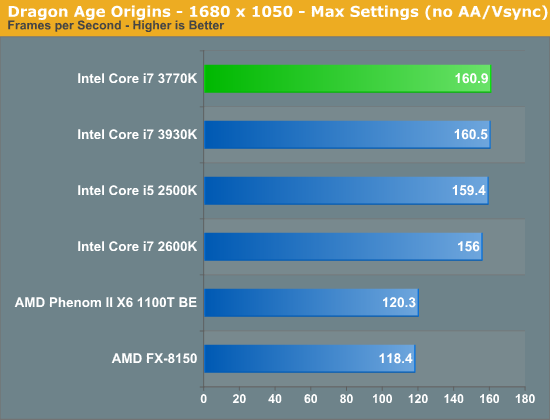
Dawn of War II
Dawn of War II is an RTS title that ships with a built in performance test. I ran at Ultra quality settings at 1680 x 1050:
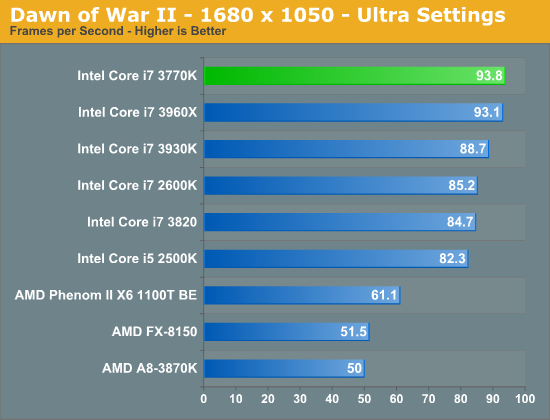
World of Warcraft
Our WoW test is run at High quality settings on a lightly populated server in an area where no other players are present to produce repeatable results. We ran at 1680 x 1050.
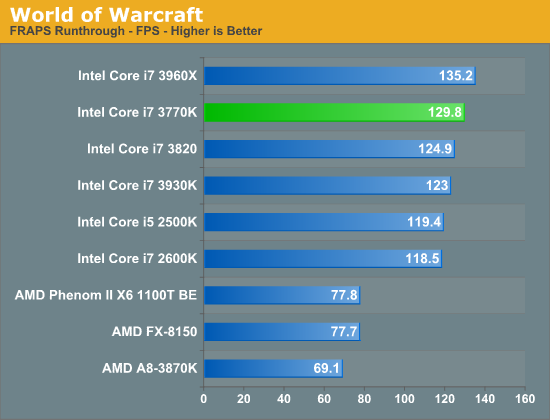
Starcraft 2
We have two Starcraft II benchmarks: a GPU and a CPU test. The GPU test is mostly a navigate-around-the-map test, as scrolling and panning around tends to be the most GPU bound in the game. Our CPU test involves a massive battle of 6 armies in the center of the map, stressing the CPU more than the GPU. At these low quality settings however, both benchmarks are influenced by CPU and GPU. We'll get to the GPU test shortly, but our CPU test results are below. The benchmark runs at 1024 x 768 at Medium Quality settings with all CPU influenced features set to Ultra.
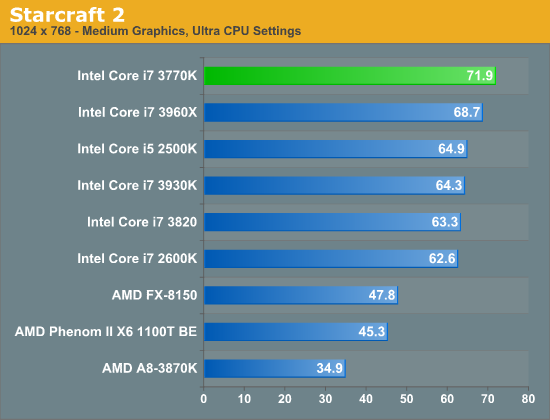
Metro 2033
We're using the Metro 2033 benchmark that ships with the game. We run the benchmark at 1024 x 768 for a more CPU bound test as well as 1920 x 1200 to show what happens in a more GPU bound scenario.

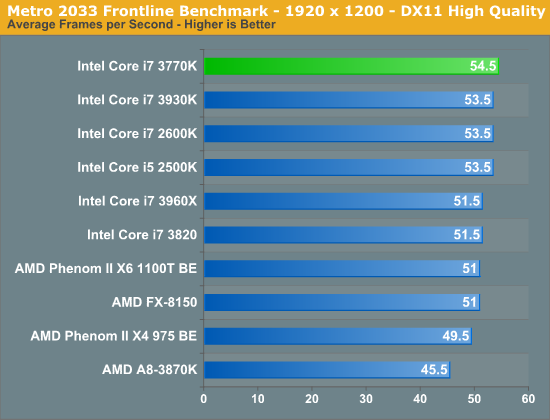
DiRT 3
We ran two DiRT 3 benchmarks to get an idea for CPU bound and GPU bound performance. First the CPU bound settings:
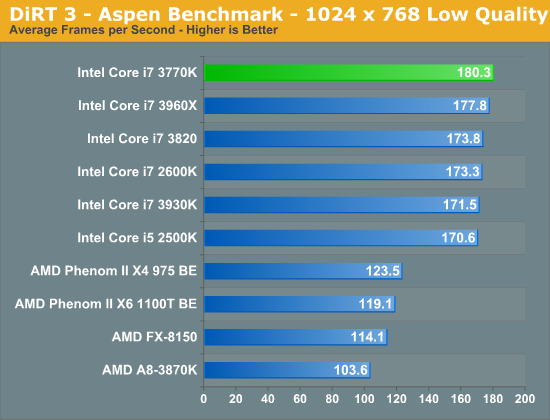
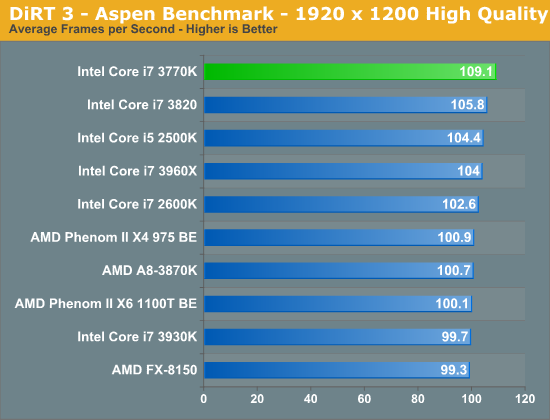
Crysis: Warhead
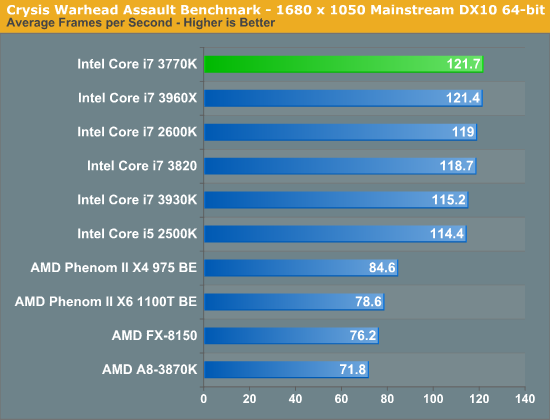
Civilization V
Civ V's lateGameView benchmark presents us with two separate scores: average frame rate for the entire test as well as a no-render score that only looks at CPU performance. We're looking at the no-render score here to isolate CPU performance alone:
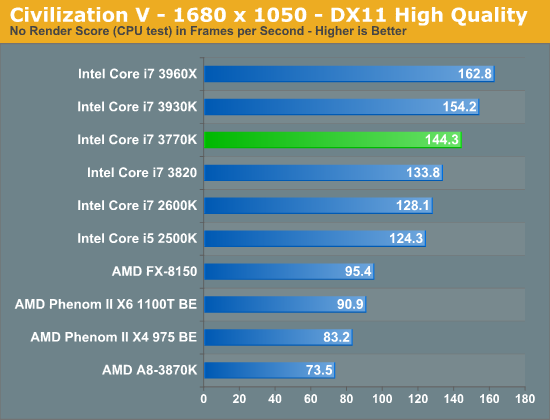










195 Comments
View All Comments
fic2 - Wednesday, March 7, 2012 - link
I totally agree. Intel is again going to cobble the lower end with the HD2500 graphics so that people that don't need the i7 cpu have to buy a discrete video card. I really wish review sites would hammer Intel for this and pressure them to include the better integrated graphics. It's not like the HD4000 is so good that people will buy an i7 just for the graphics.Jamahl - Thursday, March 8, 2012 - link
HD4000 takes up more die space which means it costs them more. That's all intel cares about, they don't give a shit about what people need at the lower end.They were forced to start using HD3000 graphics in all their lower end chips because of Llano. The 2105 basically replaced the 2100 at the same money so they would be less embarrassed by Llano. That's what competition does.
Death666Angel - Wednesday, March 7, 2012 - link
I like this tick. The CPU performance goes up by as much as I expected and the iGPU side goes up significantly.If I had the spare change to throw around, I'd upgrade from my 3.8GHz i7 860. But as it is now, an upgraded CPU wouldn't do much for me in terms of gaming performance and I rarely do CPU intensive tasks these days. The chipset and native USB 3.0 are nice, but I'll wait for Haswell next year and get a good GPU or two instead.
tiro_uspsss - Wednesday, March 7, 2012 - link
I'm a little confused :/the 3770K consistently beat the 3820 (by a very small margin)
*wait*
oh.. I found out why.. the specs of the 3820 as listed in the 'line up' are incorrect - the 3820 'only' turbos to 3.8 not 3.9.. is this why the 3770K did a little better?
aside from the small extra turbo that the 3770K has, the 3820 has more L3, more memory channels & a higher core clock (that's if the core clock listed for the 3770K is correct)
soooo.. the extra turbo.. is that why the 3770K is slightly better all-round?
Death666Angel - Wednesday, March 7, 2012 - link
You know that they are different CPU generations, right? One is SNB-E on a 32nm process node and the other is IVB on a 22nm node. The review said that IVB has a 5-15% higher IPC.tiro_uspsss - Wednesday, March 7, 2012 - link
*slaps own forehead* DUH! thats right! I forgot! :D I knew I was forgetting something! :P :D thanks! makes sense now! :)BSMonitor - Wednesday, March 7, 2012 - link
The number scheme is misleading.3820 and up are SNB-E.
3770K is Ivy Bridge.
An IVB core will perform better than a SNB core clocked at the same speed.
New architecture wins over cache, memory channels, clock speed.
Shadowmaster625 - Wednesday, March 7, 2012 - link
"Generational performance improvements on the CPU side generally fall in the 20 - 40% range. As you've just seen, Ivy Bridge offers a 7 - 15% increase in CPU performance over Sandy Bridge - making it a bonafide tick from a CPU perspective. The 20 - 40% increase on the graphics side is what blurs the line between a conventional tick and what we have with Ivy Bridge.""Being able to play brand new titles at reasonable frame rates as realistic resolutions is a bar that Intel has safely met."
hansmuff - Wednesday, March 7, 2012 - link
The review is good, I really like that you added the compilation benchmark for chromium -- good job!I'm a little disappointed in the lack of overclocking information. What is the point of reviewing the K edition of this chip without even doing a simple overclock with a comparison to 2600K in terms of power draw and heat?
Silenus - Wednesday, March 7, 2012 - link
That is because this is NOT a review...it's just a preview. I'm sure they will do some overclocking testing in the full review later. Those results would be more meaningful then anyway as this is still early hardware/drivers.